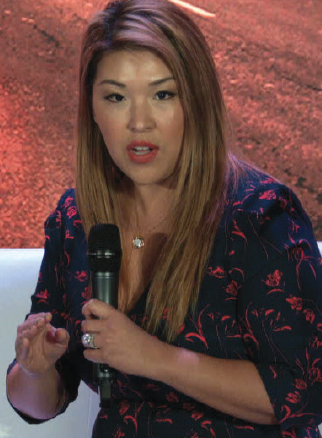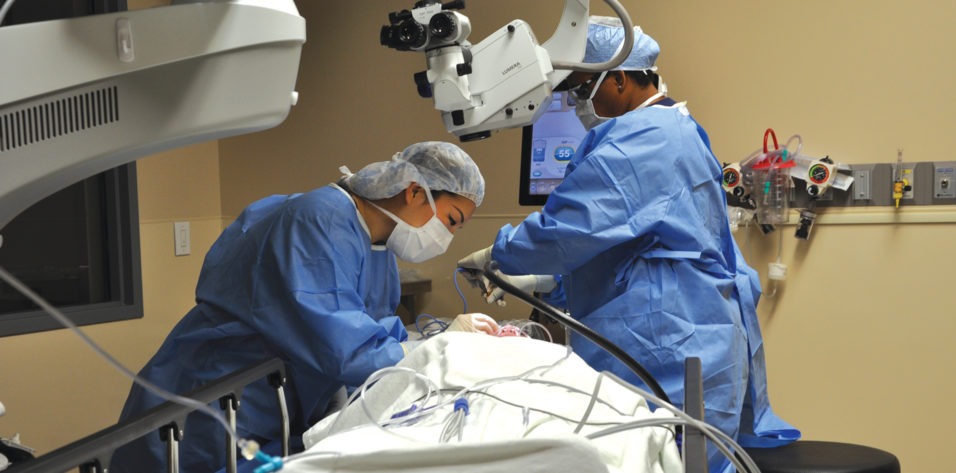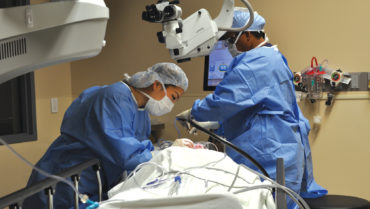Elizabeth Yeu, MD, does not profess to represent women ophthalmologists or young practitioners, but individuals in both of those overlapping groups can relate to her. When she steps up to the podium, women and young ophthalmologists can see themselves reflected in her experience. Those eager to make their own inroads into the inner circle of leadership, as she has, can look to her as a role model. In this article, Dr. Yeu describes her journey to becoming a young, female opinion leader and the responsibilities that she feels in that position.

Dr. Yeu on the podium at the 2017 MillennialEYE Live Nashville meeting.
If I am now considered an opinion leader, I owe it all to my mentors. I trained as a fellow at the Cullen Eye Institute of Baylor College of Medicine with Douglas D. Koch, MD, and Stephen Pflugfelder, MD, and I was subsequently asked to join the faculty there. Being a faculty member alongside those trailblazers was a blessing that opened doors for me. Dr. Koch recommended me for an active role in a clinical committee of ASCRS. That led to my involvement with the ASCRS Young Physicians and Residents Education Committee, now called Young Eye Surgeons (YES), which I chaired for 4 years. Meanwhile, if an opportunity arose for Dr. Pflugfelder to speak or write about ocular surface disease but he could not accommodate the request, he often recommended me for the assignment. Because I trained with him, I learned from a world expert, and this was of paramount importance in my path to working with industry in the area of dry eye disease (DED).
At the time I was in residency, Allergan and Alcon were each putting great effort into educating young physicians. When the opportunity came to work closely with Taryn Conway, Allergan’s executive director for DED marketing, I was excited to do so. She was kind and never treated me like the new kid on the block, despite my youth. That meant a lot to me. She and others at the company behaved responsibly while helping me to develop my presentations about how cyclosporine ophthalmic emulsion 0.05% (»Restasis; Allergan) can have a positive effect in many aspects of ocular surface disease.
The latitude that they gave me to develop my own ideology and information to represent the product was vital to my involvement. If the circumstances had been different, I do not know if I would have gotten involved.
Now that the doors are open for me to act as an opinion leader, whenever I am asked to discuss a certain topic or technology I feel like I am representing women and young practitioners. There are growing numbers of women thought leaders who are willing to put in the effort to play in the same league with the men, although a great disparity in numbers still exists.

Dr. Yeu speaking to the audience at the 2017 MillennialEYE Live Nashville meeting.
That being said, more women are graduating in our field, so there is an ongoing shift in the demographics of eye care professionals today. There is definitely a need for a diverse range of thought leaders in our specialty, and there is a desire on the part of industry to reflect that diversity, so opportunities are there for women and other minority groups.
…
The key is to figure out what you want: Are your interests in the path of peer and resident education, or do you lean toward the creation and introduction of new technologies and techniques? The closer you home in on areas you would like to participate in, the more those opportunities will present themselves.

Dr. Yeu speaking at the American Academy of PAs.
These opportunities, initially, probably will not involve presenting papers on a national stage at annual meetings; more likely they will start with small industry-sponsored dinners or roundtable discussions where your expertise can be of value. But these small opportunities are exactly what you need to help you decide whether or not you want to partner with a given company or represent a certain product. Your choices ultimately determine your particular path to the podium.




